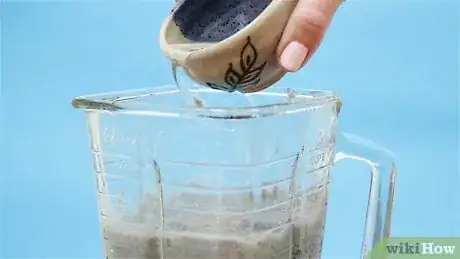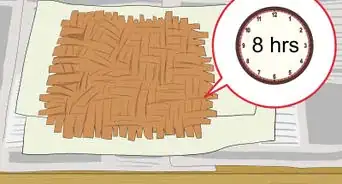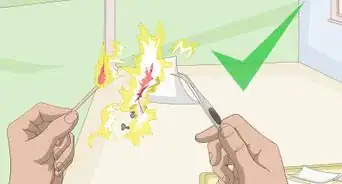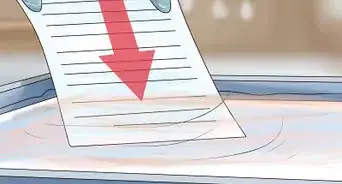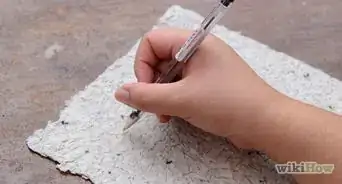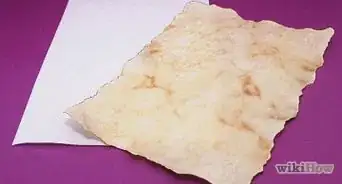This article was co-authored by wikiHow Staff. Our trained team of editors and researchers validate articles for accuracy and comprehensiveness. wikiHow's Content Management Team carefully monitors the work from our editorial staff to ensure that each article is backed by trusted research and meets our high quality standards.
The wikiHow Video Team also followed the article's instructions and verified that they work.
This article has been viewed 244,115 times.
Learn more...
Paper pulp can be a useful ingredient in making homemade paper or other crafts. It's also fairly simple to make. As long as you have paper, water, and a kitchen whisk or blender, you can make plenty of paper pulp at home. If you need to make paper pulp for a specific project, plan to mix it at least 1-2 days in advance so it has time to soak and dry.
Steps
Soaking Paper
-
1Rip the paper into small pieces. Construction paper or newspaper works well for making paper pulp, but you can use any paper that you have on hand. Tear the paper into small scraps so it will be easier for water to soak into it.[1]
- As a rule of thumb, the paper scraps should be about 1 inch (2.5 cm) long and wide.
- Rip the paper by hand for the best results. Cutting the paper with scissors is doable but won't work as well. The water will soak better into the paper if it has rough edges.
-
2Place the paper into a bowl. Choose a bowl that can fit all of your paper scraps without overflowing. You will also need to cover the scraps with water, so make sure you place the scraps in a bowl large enough that it won't spill if you cover them with water.Advertisement
-
3Add hot water to the bowl. Fill the bowl with water until you immerse the paper completely in the water. The water level should be just enough to cover the paper but no higher. In terms of temperature, the water should be hot, but not boiling, to soften the paper faster.[2]
-
4Let the paper soak overnight. Place the bowl somewhere that it can sit undisturbed for about 8-12 hours or overnight. If you need to make the paper pulp for a specific date, plan ahead so you have enough time for soaking the ripped pieces.
- If you plan on using a blender, you don't have to let the paper soak all night. It will, however, give the pulp a softer consistency.
Making Pulp
-
1Break the pieces with your hands or a kitchen whisk. Place your hands or whisk into the bowl and mix the pieces until they break down into a pulp. Continue pounding the paper until it reaches the consistency of a thick soup. When you can't see any paper pieces in the pulp, you can either dry the pulp or blend it for a smoother consistency.
- If you do not blend the paper after breaking it down with your hands, it may have a rougher texture that is harder to write on.
-
2Blend the paper pulp for the smoothest consistency. Pour the bowl's contents into a blender and turn it on for about 15-30 seconds. If you are using a thicker paper, like cardstock or cardboard, you may need to blend the paper for longer. After 15 seconds, stop the blender and check how well blended the pulp is. Continue this process until your blender has mashed the pulp into a smooth, fluid consistency.[3]
- Depending on how much pulp you're making, you may want to blend it in batches. If you choose this option, mix all of the batches back together in a bowl when you're finished blending for a uniform consistency.
-
3Add water if the pulp is too thick. Thick, dry pulp will not create smooth paper. If the pulp seems dry after blending, add a few tablespoons of water. Pour the water in small amounts and blend it for 10 seconds before adding more. Too much water can make the sheets overly fragile.[4]
- If the pulp is watery and lacks a thicker, soup-like consistency, it is most likely too thin.
-
4Mix in 1-2 teaspoons (0.16-0.32 oz) of instant starch (optional). Starch can help the pulp hold together better as it dries into paper later on. How much starch you add depends on how much paper pulp you're making. For small or medium batches (around 1-2 cups (8-16 oz) ), 1 teaspoon (0.16 oz) is enough. If your batch is larger, however, add twice the amount.[5]
-
5Store the pulp in a sealed bucket or bottle, if needed. Until you're ready to dry the paper pulp, you can store it in a sealed container to keep it from drying out. If you will need large quantities of paper pulp at once, you can make some in advance and store it for later.[6]
- You can store paper pulp for up to a week at a time.
Drying Paper Pulp
-
1Pour the paper pulp into a flat pan. Spread the pulp as thinly and evenly across the pan as possible to make uniform pieces of paper. Use your hands or a large spoon to flatten the pulp. If you cannot easily spread the paper pulp around, it may be too thick.
- If the pulp is too thick, add more water to thin out its consistency.
-
2Place a non-rusting screen into the bottom of the pan. Use a screen that is approximately the same size as your pan. Move the screen around until it is evenly covered in the pulp.
- If you have an old, torn window screen, cut it to the size of your pan and use it to make paper pulp.
- You can also buy non-rusting screens from hardware or home improvement stores if you don't have old window screens.
-
3Lift the screen out of the pan. Hold it over the pan to catch drips for about 30-60 seconds. This will prevent the screen from dripping as you lay the pulp down to dry.[7]
-
4Lay out the screen on an absorbent surface. Place the screen facedown on a towel or absorbent cloth that can soak the water in as the paper pulp dries. Lift the screen off carefully and either use it to make more paper or rinse it off if you don't have any pulp left.[8]
-
5Let the paper pulp dry for about 24 hours. Most paper pulp will take a day to dry, though thicker pieces of paper may take longer. After a day, check the paper for dryness. If it's dry and holds together, it's ready to use.[9]
Community Q&A
-
QuestionWhat if I don't have a food processor?
 Community AnswerA blender will work. Or, you can use your hands to beat it up.
Community AnswerA blender will work. Or, you can use your hands to beat it up. -
QuestionIs it okay if the pulp dries while processing?
 Community AnswerYes. As long as the glue has not yet been added, the mixture can be rehydrated by adding more water.
Community AnswerYes. As long as the glue has not yet been added, the mixture can be rehydrated by adding more water. -
QuestionIs there a way to make the paper white?
 Community AnswerWhile certain dyes can help, the best way to get white pulp is to use plain white paper. Mixing in lighter colors can be beneficial.
Community AnswerWhile certain dyes can help, the best way to get white pulp is to use plain white paper. Mixing in lighter colors can be beneficial.
Things You'll Need
- Paper
- Bowl
- Water
- Starch
- Blender
- Spoon
- Kitchen whisk
- Pan
- Non-rusting screen
References
- ↑ https://thecraftyclassroom.com/craft-recipes-2/how-to-make-paper-pulp/
- ↑ https://www.eekwi.org/activities/arts-crafts/make-your-own-paper
- ↑ https://www.motherearthnews.com/diy/making-paper-zmaz93djzraw
- ↑ https://www.motherearthnews.com/diy/making-paper-zmaz93djzraw
- ↑ https://www.eekwi.org/activities/arts-crafts/make-your-own-paper
- ↑ https://www.motherearthnews.com/diy/making-paper-zmaz93djzraw
- ↑ https://tinkerlab.com/how-to-make-paper/
- ↑ https://www.eekwi.org/activities/arts-crafts/make-your-own-paper
- ↑ https://tinkerlab.com/how-to-make-paper/
About This Article
To make paper pulp, tear the paper into small pieces and soak the pieces in water overnight. Next, break the pieces down with your hands until the pulp reaches the consistency of a thick soup. Then, put the pulp in a blender and pulse it on a high speed for 15-30 seconds until the consistency is as smooth as possible. Finally, pour the paper pulp into a flat pan and let it dry for about 24 hours before using it! For tips on storing wet paper pulp, read on!

